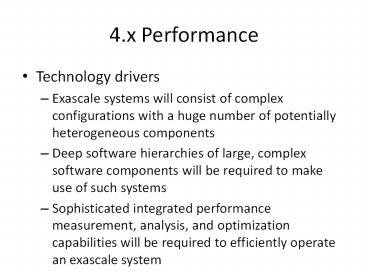4.x Performance - PowerPoint PPT Presentation
Title:
4.x Performance
Description:
Enable model-based steering. Better ... Automated / automatic diagnosis ... Performance optimization for other metrics than time (e.g. power and resiliency) ... – PowerPoint PPT presentation
Number of Views:9
Avg rating:3.0/5.0
Title: 4.x Performance
1
4.x Performance
- Technology drivers
- Exascale systems will consist of complex
configurations with a huge number of potentially
heterogeneous components - Deep software hierarchies of large, complex
software components will be required to make use
of such systems - Sophisticated integrated performance measurement,
analysis, and optimization capabilities will be
required to efficiently operate an exascale system
2
4.x Performance
- Alternative RD strategies
- Performance-aware design and implementation
- Stronger emphasis on modeling and auto-tuning
- Self-optimizing frameworks and runtime systems
- Optimization for power or resiliency
3
Priority Research Direction (Performance Modeling)
Key challenges
Summary of research direction
- Modeling of complex, large, potentially
heterogeneous computer systems and applications - Methodology development
- Architecture and application complexity
- Accuracy
- Concurrency
- Dynamic/runtime performance model
Potential impact on software component
Potential impact on usability, capability, and
breadth of community
- Enable model-driven design and implementation of
software - Enable model-based steering
- Better informed, lower risk procurements
- Better application / architecture mappings
- Higher sustained performance
4
Priority Research Direction (Performance
Measurement and Analysis)
Key challenges
Summary of research direction
- Develop scalable collection (online reduction
and filtering, clustering), analysis (clustering,
data mining), and visualization (hierarchical) - Support for heterogeneous hardware and hybrid
programming models - Automated / automatic diagnosis
- Vertical integration across software layers (OS,
compilers, runtime systems, middleware,
application) - Performance analysis in presence of noise and
faults - Performance optimization for other metrics than
time (e.g. power and resiliency) - Engage vendors to improve performance
information streams
- Perturbation and data volume
- Concurrency
- Heterogeneity
- Drawing insight from measurements
- Quality information sources
Potential impact on software component
Potential impact on usability, capability, and
breadth of community
- More scalable, capable, easier-to-use tool
environments - Improved interoperability and standards
- More modular and reusable tools
- Higher sustained performance
- Boosting value of HPC investments
- Increase scientific productivity
5
Priority Research Direction (Autotuning)
Key challenges
Summary of research direction
- Methodology development for runtime adaptivity
- Common methods and harnesses for implementing
autotuning - Coordination of heterogeneous resources by OS
- Using parallelization of performance experiments
to speed searches
- Wider applicability
- Impractical search spaces
- Dynamic adaptation
- Heterogeneity
Potential impact on software component
Potential impact on usability, capability, and
breadth of community
- Common frameworks for autotuning speeds adoption
and progress by application software
- Increase the value of investments in HPC by
keeping performance closer to optimality - Lowered costs for performance engineering done
automatically in the field rather than by
specialists
6
4.x Performance
Performance modeling, simulation,measurement and
analysis
Handle Billon-way concurrency
Characterize performance of exascale HW SW for
app enablement
Handle millon-way concurrency
Handle 300 millon-way concurrency
Processing Rate
Support for hybridprogramming models
Predictive exascalesystem design
Handleheterogeneous HW
2010
2011
2012
2013
2014
2015
2016
2017
2018
2019
7
4.x Performance
- Recommended research agenda
- Develop scalable performance measurement
collection (online reduction and filtering,
clustering), analysis (clustering, data mining),
and visualization (hierarchical) - Support for heterogeneous hardware and hybrid
programming models - Automated / automatic diagnosis / autotuning
- Vertical integration across software layers (OS,
compilers, runtime systems, middleware,
application) - Performance analysis in presence of noise and
faults - Performance optimization for other metrics than
time (e.g. power) - Engage vendors to improve performance
information streams
8
4.x Performance
- Crosscutting considerations
- Performance-aware design, development and
deployment of hard- and software - Integration with OS, compilers and runtime
systems - Support for performance observability in HW and
SW (runtime)































